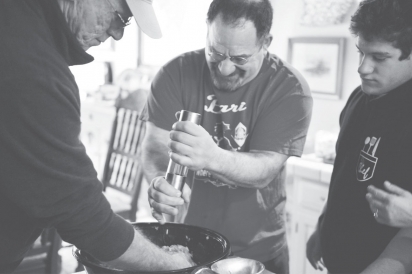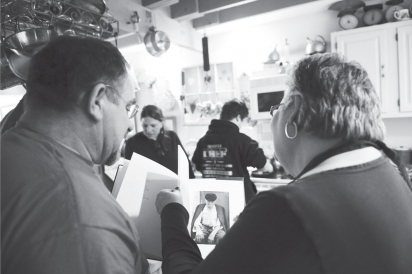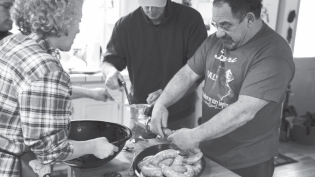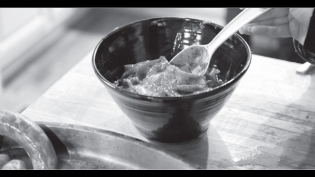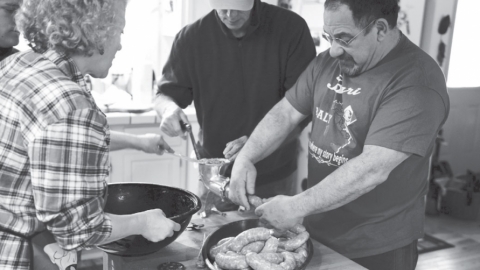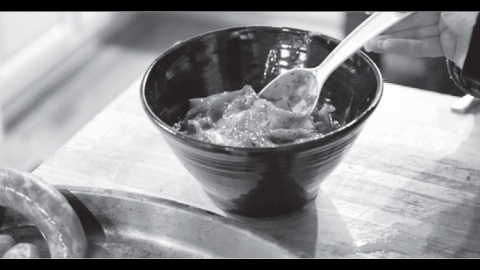Sausage, Italian Style
Smashing, Seasoning, Spicing, Stuffing… Sausage
Pork, fennel, salt, pepper and wine—how can so few ingredients produce such amazing taste and hold such strong tradition?
People make Italian sausage in dozens of different ways, in hundreds of communities in Italy. And in Grand Traverse County, there are a handful of families using age-old recipes to make the delectable meat we call “sausage.” There are even some families making the fancy prosciutto and pancetta, typically from northern Italy— the difference being that fresh sausages are ready to cook and cured meats are ready to eat.
Local home sausage makers Frank and Marie Dituri say it’s the simplicity—plus a few secrets—that make great sausage.
With a humming kitchen of helpers, wine poured for all, Sinatra and Bocelli singing in the background, we might be in Italy. But we’re in the Dituri home on the banks of the Boardman River where Frank says that it’s fresh, it’s local, it’s simple “and we make it in a way that brings the past into the present.”
“I’m always thinking of Uncle Lou when we make sausage,” says Frank.
With instructions handed down from both Marie’s and Frank’s grandparents—and that vary depending on who is helping—today a stainless steel hand grinder that Frank’s grandfather Vito used since sometime after he immigrated in 1914 is emblematic of the tradition that is the real binding in their recipe.
As Frank passes sausage secrets to his son Rocco, it’s clear that the making is as important to the outcome as is the final preparation and cooking.
It’s a process—a messy, wet process—that requires many hands. When Frank and Marie make sausage, they typically throw a party to get it done.
The work becomes lighter as everyone takes shifts with the different jobs—grinding, mixing, spicing, stuffing. There’s lots of conversation, loud advice and laughter. Best of all: Everyone will enjoy the fruits of their labors on this day.
“We never use garlic in sausages. My father used to say if there’s garlic in the sausage, that’s not Italian sausage, that’s Polish sausage,” Frank jokes. But that’s what my Italian father says too.
From the Dituri home to specialty shops like Burritt’s in Traverse City, Italian sausages—made locally—are abundant even in Northern Michigan.
Sausage-making is really the result of efficient butchery, where makers use salt to preserve various tissues, organs and all of the scraps—including the blood and fat—then stuff them into the cleaned intestines of the animal itself. Sausages, along with salami, are among the oldest prepared foods in human history.
The most famous sausages trace back to none other than Italy, where they were celebrated in festivals, the focus of feast days and all special occasions.
But as important as enjoying the finished sausage has always been, it was and still is the making of them that makes all the difference to true sausage lovers.
“We treasure our heritage, especially as it relates to the wonderful food choices we have,” Frank says. That’s why for more than 20 years the Dituris have hosted sausage-making parties that usually yield 40 to 80 or more pounds of sausage with everyone taking home a share.
Antonietta (Toni) Stanfield, one of the fortunate guests, tells me, “it is really us—the Italian-Americans—who are carrying on the food traditions for the generations to come.
“In Italy people aren’t getting married, aren’t having kids, and so … these pieces of our culture are dissolving. If we don’t teach them to the next generation, no one else will,” she says.
Rocco is studying at the Great Lakes Culinary Institute to be a master chef, and works as a cook at The Boathouse restaurant on Old Mission Peninsula. Rocco along with his older sister and brother have been part of this sausage-making tradition since they were tall enough to stand beside the grinder and crank.
When these generations intertwine during the sausage grinding, it’s clear they each have important ingredients to add to the experience. Rocco is learning different ways than his dad has learned and even Uncle Lou, but combined they may create yet another generation of flavors.
With a decisive nod, he tells Frank that the bit of sausage that he just cooked up has the right spice. This one will be hot, and includes hot Italian peppers preserved in oil from Marie’s brother.
The production of these peppers is another family tradition incorporating the use of seeds from the hottest peppers to make the next year’s batch. Just smelling these peppers can make your eyes water. But surrounded by the salt, wine and fennel they make the sausage come alive.
“Italian sausage” refers to the fennel or anise as the distinct seasoning. In Italy, there are many types of sausage and they all vary from what we know here in the States. But they do fall into one of two categories: sweet or hot. The difference between the two? Hot has spices that will make your mouth warm and sweet does not.
As for those fortunate guests? The crisp outer coating of those near-perfect spices all mixed together and hot off the grill, topped with peppers that have been sautéed to softness, served on a bun—three hours isn’t too long to wait for this dinner.



